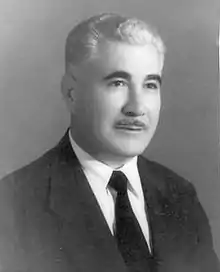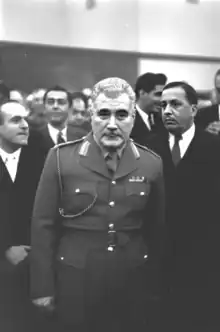Muhammad Najib Ar-Ruba'i | |
|---|---|
 Ar-Ruba'i in 1960 | |
| 1st President of Iraq | |
| In office 14 July 1958 – 8 February 1963 | |
| Prime Minister | Abd al-Karim Qasim |
| Preceded by | Faisal II (as the King of Iraq) |
| Succeeded by | Abdul Salam Arif |
| Personal details | |
| Born | 14 July 1904 Baghdad, Baghdad Vilayet, Ottoman Empire |
| Died | 1965 (aged 60–61) Baghdad, Iraq |
| Nationality | Iraqi |
| Political party | Independent |
| Occupation | President of Iraq (1958–63) |
| Signature |  |
| Military service | |
| Allegiance | |
| Branch/service | |
| Years of service | 1924-1963 |
| Rank | |

Ar-Ruba'i in military uniform in 1959.
Muhammad Najib Ar-Ruba'i (Arabic: محمد نجيب الربيعي) (also spelled Al-Rubai) (1904–1965) was the first president of Iraq (Chairman of Sovereignty Council), from 14 July 1958 to 8 February 1963.[1] Together with Abdul Karim Qassim,[2] he was one of the leaders of the 14 July Revolution that toppled King Faisal II in 1958.
While Qassim became prime minister and held most of the power, Ar-Ruba'i was elected head of state with the title of Chairman of the Sovereignty Council. The Sovereignty Council had a representative from each of the communal/ethnic groups. Ar-Ruba'i represented the Sunni community.
In 1963, Qassim was deposed by another coup led by Abd as-Salam Arif. Ar-Ruba'i had to retire from politics. Ar-Ruba'i died in 1965.
References
- ↑ Cahoon, Ben (2000). "Iraq - Chronology" (web). worldstatesmen.org. Retrieved 25 May 2008.
- ↑ "Iraq PROFILE" (web). U.S. Department of State. Retrieved 25 May 2008.
This article is issued from Wikipedia. The text is licensed under Creative Commons - Attribution - Sharealike. Additional terms may apply for the media files.